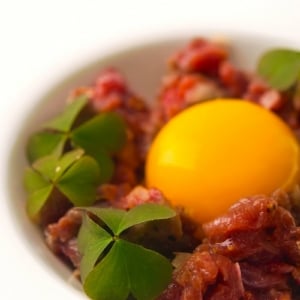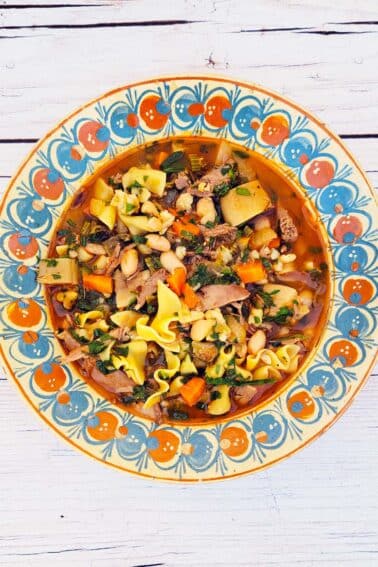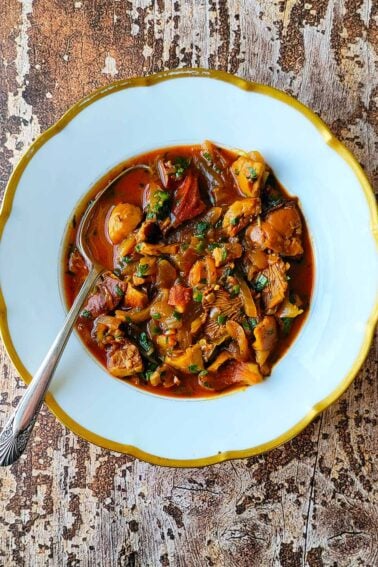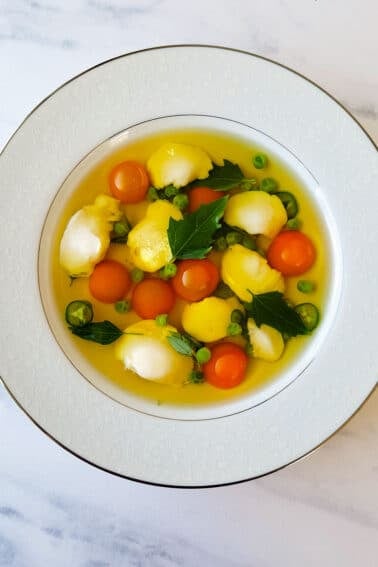As an Amazon Associate I earn from qualifying purchases.

Beef or venison tartare is the “trust fall” of the culinary world: Raw meat and a raw egg yolk. If your ingredients are not impeccable, things can go very, very wrong. But done right, this is at once a primal and exciting little appetizer.
Tartare is all about texture. Raw meat has a savory slipperiness that causes many people to argue within themselves. It seems so wrong, almost dangerous, yet something deep within you urges you to take another bite. It’s our inner hominid talking.
Beyond the meat, the silky richness of the broken yolk acts as a sauce, flecks of herbs or other flavors sparkle here and there, and the decided crunch of raw shallot punctuates each bite.
I know what you’re thinking: No way I’d eat raw venison! It’s not a crazy concern. But here’s what you need to know to eat raw venison (deer, antelope, moose, elk, etc) as safely as possible:
- Shoot straight. Seriously. If’ you’ve gut-shot the animal, think twice about making it into tartare or carpaccio. E. coli, both the really nasty o157 variety as well as the nasty-but-non-lethal o103 strain exist in venison (and all other ruminants). It mostly lives in the digestive tract. So if you break that tract and get gut gunk all over the inside of your deer, you better cook it well.
- Cut cleanly. This is an extension of No. 1. If you break the guts while eviscerating the animal, it’s nearly as bad as gut-shooting it.
- Freeze your venison first. Should the venison have any larval parasites, and parasites such as tapeworm and toxoplasma gondii (which causes toxoplasmosis) are know to exist in deer. Freezing the meat below 0°F for at least two days will go a long way toward making any raw meat you eat safer.
- Avoid any possible cross-contamination. Your venison might be perfectly fine, but if you have a dirty cutting board or knife or even hands you can wreck the whole thing. Sanitation is very important when serving raw food.
- Keep cool. Just as sushi should be served cold, so should tartare. Work quickly and keep the venison in the fridge when you are not cutting or mixing it.
Even so, this is not a 100 percent risk-free recipe. But then again, neither is a trip to your neighborhood sushi bar. Or your breakfast — you are far more likely to get salmonella from eggs than you are from getting sick from raw venison, if you follow the steps above. Needless to say, your egg needs to be of the finest quality to use for tartare.
So if you’re still with me, let’s make tartare.
Some people, notably Wisconsinites, seem to like their beef or venison tartare ground. I don’t. I prefer it minced, which I think has a better texture. Use a large, very sharp chef’s knife to mince the venison. Take your time and don’t chop it like you would herbs: It will get all stringy.
My advice if you are going to make this recipe for more than four people is to cut the venison into manageable pieces first, then keep them all in the fridge. Mince one piece at a time and then return it to the refrigerator: This keeps everything cold.
After that, personalizing your venison tartare is all just a question of seasonings. Mine are woodsy, with juniper and caraway. The garnish is wood sorrel, which tastes lemony; it’s a hat tip to Chef Rene Redzepi of NOMA, who uses wood sorrel in his tartare.
Venison Tartare
Ingredients
- 1 shallot, about 1 heaping tablespoon, minced
- 3 tablespoons red wine vinegar
- 1 heaping teaspoon juniper berries, about 8
- 1 level teaspoon caraway seeds
- 1 teaspoon black peppercorns
- 1/2 to 3/4 pound venison
- Smoked salt to taste
- 4 egg yolks
- Wood sorrel or grated lemon zest, for garnish
Instructions
- Soak the minced shallot in the vinegar in a small bowl. Toast the juniper berries, caraway seeds and peppercorns in a small pan over medium-high heat (shaking often to prevent them from burning) until they are fragrant, about 2 minutes. Move the spices to a grinder or mortar and pestle and grind to a coarse powder.
- Mince the venison with a sharp knife. I prefer to cut it into 1/8 inch dice; it helps if the meat is partially frozen first. Put the minced venison in a bowl and sprinkle over the ground spices. Drain the shallots and add them to the bowl. Add about 1/2 teaspoon of smoked salt and mix the tartare together. Add more salt to taste.
- To serve, give everyone some tartare and make a little depression in the center. Separate the egg yolks from the white and discard the whites (or use in another recipe). Put the yolks in the little depression. Garnish with the wood sorrel or lemon zest.
Notes
Nutrition
Nutrition information is automatically calculated, so should only be used as an approximation.






Well I have never even thought about eating raw meat or raw eggs, however I decided to step outside the old comfort box and give this recipe a try.I typically eat my steaks medium rare so I thought it wouldn’t be to far of a stretch.
It was good enough that I will eat it again, probably with beef next time.
Hank – so you’re essentially trying to slice small enough to get to “nearly” ground meat size?
We have a German exchange student this year and over the weekend when we were shopping he wanted to pick up some ground beef. We don’t normally buy beef, instead, using venison, but he said he wanted a traditional breakfast Sunday morning.
Sunday morning came around and he took a bread roll, crisp on the outside and soft on the inside, and heated it in the oven. He diced an onion, and then took some of the ground beef and spooned it into a bowl. He seasoned it with salt and pepper, split the roll open, spooned it onto half of the roll, then pressed it into the diced onion creating a layer of raw onion on top. That was it – he went about enjoying his breakfast. Against my better judgment, I tried one as well. It was delicious. I told him I would not have a steady diet of it here, but that I would be much more comfortable with the venison that we butcher.
The funny thing is – I pulled out your book and showed him this recipe. He saw the egg on top and said, “oh that will kill you, there’s salmonella in raw eggs”, lol. Now I really want to try your recipe with some venison! Strangely enough, I was craving that warm bun and raw meat/onion flavor for the rest of the day! He said that it’s a weekly thing – you go to the bakery and get it, anywhere. Said he’s been eating that way his whole life.
Love the use of sorrel, which grows all over my yard. Adds a nice tang to anything you use it in. I took a class called Wild Food Plants while I was a student at Michigan State, where I first found out about sorrel and may other edible plants. The instructor was John Kallas, who was a grad student at the time. He has written an excellent book titled “Edible Wild Plants” which I would highly recommend.
This is my third time I’ve prepared your outstanding recipe. The combo of toasted peppercorns, juniper berries, and caraway seeds complements the slight gaminess of the elk back strap I used.
Also, the dish went very well with my wife’s cauliflower garlic puree.
A toast to you, my friend!
So do you mix the yoke in or what?
Charann: Yes, when you eat it. It forms a sauce.
Hank!
I made a small batch of this yesterday for Christmas Eve and absolutely loved it! Dad enjoyed it but Mom wasn’t sure haha. I will be making a bigger batch today for more people to try. I used the tenderloin of a nice buck and the texture was great. Thanks for the recipe! Do you have a recipe for Salmon Tartare as well? I think that would be great alone but also good in a sushi roll.
Thanks again and Merry Christmas!
Luke
Luke: Glad you liked it! Yes, here is my salmon tartare recipe: https://honest-food.net/2012/09/02/salmon-tartare-recipe/
Hi Hank – what do you mean by shallot? It has different meanings in different countries.
Is it a green/spring onion or is it a small purple onion with skin?
Daniel: Huh. Never in all my life have I heard of a scallion/green onion being referred to as a shallot. Yes, it’s the small purple onion with skin. Where are you?
Great recipe! Turned out wonderful. Ended up making extra of the spice mixture – goes great on cooked vension also.
Hello Hank.. great info here thanks.. I just picked up a great looking piece of venison.. but it’s a flank steak.. will it still work?.. & if so can you give me some pointers on trimming it up?
Love all kinds of tartare and carpaccio. I agree with Hank, and I suspect regular meat at the grocery store would give me far more pause to consider how safe it is for serving raw. I like my tartare with a gastrique and topped with a quail egg yolk.
Hank
Well Wisconsinites have gone down in my estimation considerably, thanks for the warning!
The idea of heart tartar is thrilling, i’d not thought of that, I bet its delicious
SBW
By far one of the most beautiful pictures of food porn I have ever seen 😉
I just learned something new today.
I had always believed those weeds in my lawn were shamrocks and now I know they are called wood sorrels and that they are edible.
Thanks Hank.
Oh yeah. We are making this with fresh eggs from our chickens and meat from last year. Your tips are excellent, thanks Hank!
Ed: There is virtually zero chance of you getting trichinosis from venison. Has it happened? Yes. But more people are eaten by sharks every year than get trichinosis from venison. My data is from the USDA, and I think they are super cautious about these things: Remember that a 5 degree difference is HUGE.
But the bottom line remains. Freeze for a little longer to ensure a safe product. My backstrap was frozen for months before I made this tartare.
Hank,
Articles I’ve read indicate that deer can also harbor Trichinella spiralis and other trichinae(causes trichinosis). If so, the two days at zero degrees is not sufficient to kill the parasite.
The chart I’ve used most (seen in “Home Production of Quality Meats and Sausages” by the Marianskis) can be found here https://nchfp.uga.edu/publications/nchfp/lit_rev/cure_smoke_fs.html
Interesting enough they don’t have a 0 degree F in the chart, but the times for 5* F are between 20 and 30 days.
While there are less than two dozen cases of trichinosis reported a year and pig and bear meat are the primary vector, I’d play it safe and just have a few more weeks of freezer time before I enjoyed that delicious tartare.
Erika: Yep, that works. The interior of a solid piece of meat is sterile.
Chris: I honestly don’t know. I’d be leery of it, though. I have made heart tartare from ducks and venison, but none of those animals. Could be perfectly fine, could be dangerous. Just haven’t done any research on it.
I have access to chicken, duck, turkey, rabbit, and pig hearts on our little sustainable farm. Is there any reason I shouldn’t try this with rabbit or one of the others?
Kindest,
Chris
Mmmm… I love carpaccio (and have sneaked thin shavings of raw backstap that I was prepping for the grill), and I so want to try this recipe because I happen to have juniper berries and alder-smoked salt on hand, so it’s my destiny! 😀
I’ve heard of searing the backstrap very, very lightly to “decontaminate” the surface before mincing it. Have you heard of such a thing? Or is that just not kosher for tartare?
Thanks for the venison safety tips! As the years roll on, I find that I use more & more of each deer – organ meats! tongue! belly! & cook the meat far less than to the old greyish tone that all of the past wild deer warnings require. It is great to have concrete info/handling instructions to further ease my mind.
What do you think about kid-goat tartare? We have some kids ‘coming to dinner’ soon & this has my mouth watering!